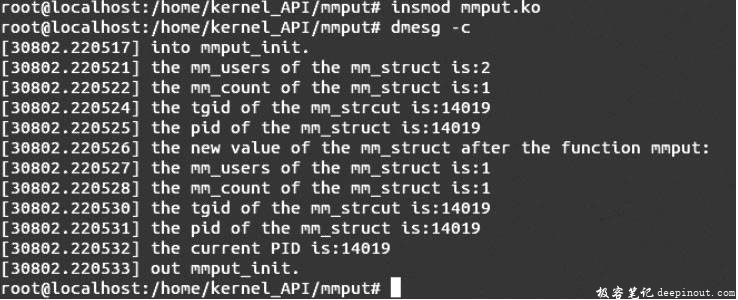mmput函数功能描述:此函数用于减少任务对应的内存空间的用户的数量,并在当用户数量减少到0时释放任务所占用的内存空间。
mmput文件包含
#include <linux/sched.h>
mmput函数定义
在内核源码中的位置:linux-3.19.3/kernel/fork.c
函数定义格式:
void mmput(struct mm_struct *)
mmput输入参数说明
此函数的输入参数是一个struct mm_struct类型的结构体变量,对应任务的内存空间,其定义及详细解释参考get_task_mm( )。
mmput返回参数说明
此函数的返回值是void类型的变量,即不返回任何结果。
mmput实例解析
编写测试文件:mmput.c
头文件引用:
#include <linux/module.h>
#include <linux/sched.h>
#include <linux/pid.h>
#include <linux/mm_types.h>
MODULE_LICENSE("GPL");
模块加载函数定义:
static int __init mmput_init(void)
{
printk("into mmput_init.\n");
struct pid * kpid=find_get_pid(current->pid); //获取当前进程的描述符信息
struct task_struct * task=pid_task(kpid, PIDTYPE_PID); //获取新进程的任务描述符信息
struct mm_struct * mm_task=get_task_mm(task); //获取进程对应任务的内存信息
/*显示字段mm_users和字段mm_count的值*/
printk("the mm_users of the mm_struct is:%d\n", mm_task->mm_users);
printk("the mm_count of the mm_struct is:%d\n", mm_task->mm_count);
/*显示与此mm_struct相关进程的父进程的TGID和PID*/
printk("the tgid of the mm_strcut is:%d\n", mm_task->owner->tgid);
printk("the pid of the mm_struct is:%d\n", mm_task->owner->pid);
mmput(mm_task); //调用函数mmput( )释放进程的内存空间
printk("the new value of the mm_struct after the function mmput:\n");
/*显示函数mmput( )调用之后的进程对应内存空间部分字段的值*/
printk("the mm_users of the mm_struct is:%d\n", mm_task->mm_users);
printk("the mm_count of the mm_struct is:%d\n", mm_task->mm_count);
printk("the tgid of the mm_strcut is:%d\n", mm_task->owner->tgid);
printk("the pid of the mm_struct is:%d\n", mm_task->owner->pid);
printk("the current PID is:%d\n", current->pid); //显示当前进程的PID值
printk("out mmput_init.\n");
return 0;
}
模块退出函数定义:
static void __exit mmput_exit(void)
{
printk("Goodbye mmput\n");
}
模块加载、退出函数调用:
module_init(mmput_init);
module_exit(mmput_exit);
实例运行结果及分析:
首先编译模块,执行命令insmod mmput.ko插入模块,然后执行命令dmesg -c,会出现如图所示的结果。

结果分析:
由上图可以看出函数mmput( )运行之后字段mm_users的值减小了,即任务的用户数量少了一个。
在函数mmput( )执行之初,调用了函数might_sleep( ),这样就给进程之间的切换提供了机会。
 极客笔记
极客笔记